By Jeffrey A. Rendall, Images Courtesy of Miura Golf
HEMIJI, JAPAN – Japanese golf club-making guru Katsuhiro Miura is a confident fellow, and has adopted a philosophy for the company which bears his name: ‘The good golfer will find me.’
Miura has a reason to be confident, having been in the club design and manufacturing business for over fifty years. Hailing from the Himeji region of Japan (known for its pure steel and samurai sword manufacturing tradition), Miura began making clubs in 1957, and established his own company a few years after that.
Bill Holowaty is Vice President for North American Operations for Miura Golf, and he says its Miura’s heritage and pursuit of perfection that sets the company apart: “When I’m asked to describe the Miura company, I always say first and foremost, there is a Mr. Miura.”
Holowaty continues, “I think in this day and age where there are so many large OEM’s (Original Equipment Manufacturers), there’s something that gets lost because there’s a disconnect between the people who design the clubs and those that actually make them.”
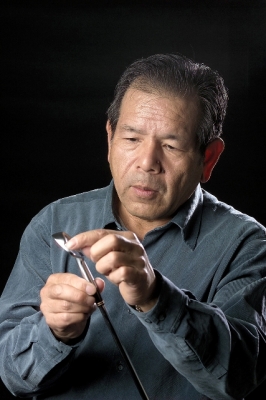 |
It’s true, since there is actually a ‘Mr. Miura,’ there’s a built-in tradition of craftsmanship with the Miura line – but it’s more than just one man or one vision. Miura has dedicated his life to the pursuit of the perfect golf club – and now his two sons (Yoshitaka and Shinei) are following in their father’s footsteps and striving to accomplish the same thing.
That’s not all. “You’re more likely than not to find Mrs. Miura in the finishing room taping off club faces pre-sandblast,” Holowaty said. “It is truly a family business in that regard, and everyone involved with Miura really strives to uphold the vision that Mr. Miura has set. We do that by recognizing that we occupy a real specific niche in this industry – and since we’re not nearly as large as some of the more well-known manufacturers, there’s a finite number of clubs that can be made in any particular year.”
It’s perhaps because of Miura’s dedication to perfection that he claimed that ‘good golfers will find me,’ but Holowaty says the saying is not meant to be boastful – and Miura clubs are not just for ‘good’ golfers, either. The literal translation of the motto in Japanese means, if Miura continues to manufacture the best possible golf clubs, then golfers will discover his products.
Mr. Miura has literally traveled the world in pursuit of perfection, and he’s even got a unique way of assessing the attributes of different golfers and the way they use the club head. “When I met Mr. Miura 25 years ago, I was hitting balls one day and what he did to me is not unlike what he’s done to many golfers over the years,” Holowaty remembered.
“He just came over and squatted down sort of next to the ball. If you can imagine I’m looking at the golf ball set-up at address – and just beyond the golf ball, he’s squatting down and looking and listening to see how the ball contacted the club. He’s watching the strike, watching the position of the head, listening for the sound – he’s a very hands-on and intuitive designer,” Holowaty added.
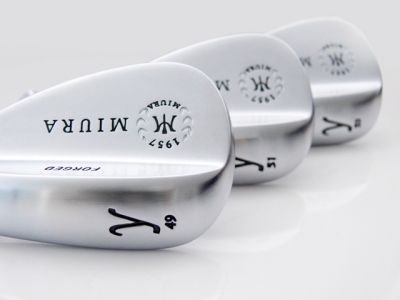 |
And it sounds like a brave one, as well.
Miura has worked with a good share of professionals over the years and is one of those behind-the-scenes experts that you don’t hear much about – but to whom those hoisting the trophy owe quite a debt of gratitude. Miura has forged clubs that won two Masters and one U.S. Open championship (amongst others), so the club master’s hands-on attention has definitely paid off at the highest levels of golf.
“I think one of the character traits that defines Mr. Miura is that he’s very willing to listen, but he’s not easily swayed,” Holowaty surmised. “You can go to him and suggest something, but he will not compromise any of his designs or manufacturing techniques for the sake of making a sale. Mr. Miura builds clubs to perform first and sell second – and that probably flies in the face of common marketing or sales logic, but it hits home with our customers and certainly our dealers.”
Performance is the word for one of Miura’s latest creations, the Series 1957 wedges, which are appropriately dedicated to the year that Mr. Miura started making golf clubs.
“With the Series 1957 wedges, we wanted to be able to deliver a product model where you know Mr. Miura’s influence was very strong,” Holowaty explained. “Our existing wedges resembled many of the top wedges that were out there in the marketplace. The Series 1957 came about because Mr. Miura – in his dealings with golfers around the globe – found that there was more versatility demanded from the wedges.”
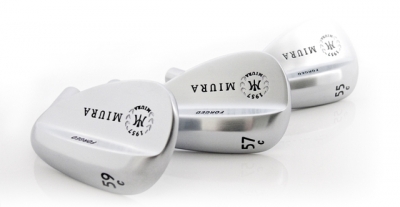 |
“Players wanted the ability to open a wedge up, to move your hands forward, to decrease or increase loft, increase or decrease bounce, hit the flop shot or even hit a low shot – so the sole grind needed to be a little bit more versatile,” Holowaty added.
Miura saw that the marketplace was full of companies introducing somewhat radical wedge designs, with significant heel and toe relief, bold trailing edges, rolled leading edges, etc… but the master club-maker didn’t want to compromise the integrity of his wedges – he didn’t want to move away from his ‘perform first-sell second’ philosophy with the 1957 Series.
In order to meet Mr. Miura’s standards, the 1957 Series wedges needed to be consistent with the length of the club so he could provide consistency throughout the set – and if there was going to be heel and toe relief, it was really necessary to assure balance in the club and that the head have the ability to square itself at impact. Miura also wanted the wedges to perform in a variety of conditions.
In other words, Miura didn’t want to go ‘radical’ with the Series 1957, but he also wanted them to be different than what was in the marketplace.
“Mr. Miura was a long time with his sons in development of these grinds. They may be a little bit different when compared to what’s out there, but what you will find is the thought that went into them in terms of performance and integrity – it has remained consistent,” Holowaty said.
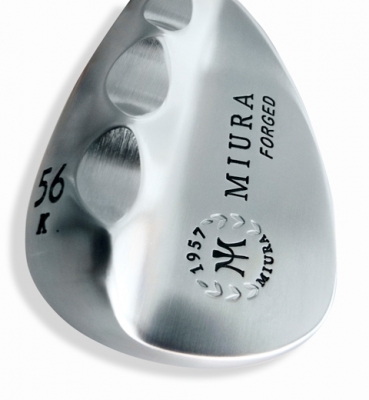 |
The wedges come in different grinds, Y and C, each with different performance characteristics.
(Note: Miura has also recently introduced the K wedges, which do look a bit ‘radical.’)
The Y grinds (which we tried) feature a low trailing edge and a low leading edge, and Holowaty says it’s the type of iron you’d hit from the fairway or maybe chips around the green. Because of the sole design, there’s built-in versatility to allow for some creativity on a variety of shots.
The quality of these wedges is evident just from the looks – but also from touching them. Again, Holowaty articulates: “Whether you buy a Miura tournament blade or the wedges, you’ll grasp the fact that they’re essentially hand-made – there’s somebody putting the grind on there. You can compare the ’57 wedge you have with the one your buddy has, and at first look they might appear identical – but if you look close there would be very subtle differences, because it’s all done by hand.”
And no discussion of wedges in 2010 would be complete without talking about grooves – whether the wedges conform to the latest regulations issued by the USGA for golf clubs in competition.
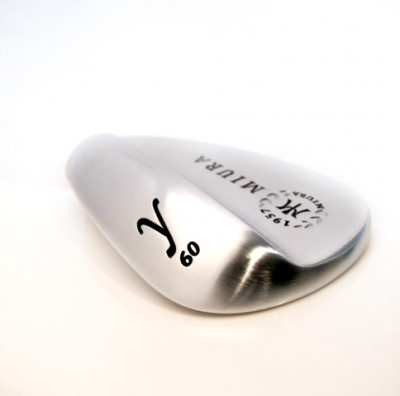 |
Holowaty says that small club manufacturers will be affected the most from the new rules, but Miura Golf has adjusted accordingly. While it will take a while for all the clubs to conform to the new standards, Miura offers product for its professional players who need it at present – and also is still producing the so-called ‘non-conforming’ wedges for recreational players (the groove rules only apply to professionals currently).
Mr. Miura was concerned that the heavy investment in equipment that will be needed to produce conforming clubs will put more strain on the Japanese industry – especially in the Himeji region – but again, Miura Golf was in position to do that.
As far as playing the wedges, we tried out the 59 degree and 53 degree Series 1957 Y-grind wedges – and found them to be as good as advertised.
I can honestly say, you will never find another golf club that looks better – you almost feel guilty getting them dirty – but their looks weren’t marred by any number of conditions that we encountered. As mid-handicappers, we’re uniquely able to find many, many, types of playing lies!
As with all the products that we feature, we can only recommend that you try the Miura line if you’re looking for high-end, hand-made golf clubs of any type. They may take a more extended search to find them, but it’s definitely worth the effort.
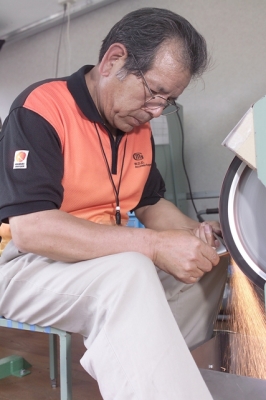 |
And in finding Miura’s work, you might even fulfill Mr. Miura’s prophecy in doing so – ‘the good golfer will find me.’
Details:
Miura Golf’s North American headquarters is in Burnaby, British Columbia.
Consult the website for dealers near you, or send inquiries to Bill Holowaty, bill@miuragolf.com. Telephone: 604-708-4653. FAX: 604-708-4663.
Toll Free: 1-866-GO-MIURA (466-4872)
Website: www.miuragolf.com
| Related Links | Comments on this article? | |
|
Maryland National Golf Club Hollow Creek Golf Club Rocky Gap Resort PB Dye Golf Club in Ijamsville Whiskey Creek Golf Club |
E-mail Jeff Rendall, Editor: jrendall@golftheunitedstates.com |












